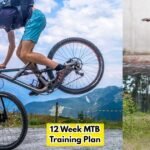After legs, core strength is another important part that is involved in mountain biking.
When you have a strong core, you can have better bike control on the trails. Especially on sharp turns, rocky descents, and while climbing steep inclines.
In this post, we will discuss ten ways to improve your core strength for mountain biking.
If you follow all these steps, then you will be able to ride your bike more effectively and for longer routes.
These mountain biking exercises will also increase your endurance and stamina, which is really important in trail biking.
Also read: 12 strength training workouts for MTB
1. Plank Variations

The Classic Plank Variation is the best exercise for core strength and even for reducing belly fat.
For this exercise, you want to stand on the forearm plank and hold it for at least 30 seconds or a minute, depending on your stamina.
However, you can progress to side planks, dynamic planks, with shoulders, like with shoulder taps.
If you want more challenges, then you can do a plank to push up variation. It’s a little more challenging but good for your core strength.
Pro tip: Make sure you engage your glutes and keep the back flat because the proper form is important for maximizing the effectiveness of the plank, as it’s a workout for mountain biking.
If you want to increase the intensity, you can also lift one leg.
Besides this, to make it a little more challenging, you can also place your feet on an unstable surface in which you will have to balance yourself to stay stable; it will help you improve your mountain biking balance on technical trials.
Also read: Complete Guide to Do Plank in a Proper Way
2. Russian Twists

The Russian Twist exercise targets your oblique muscles, which is important for managing lateral movement and cornering in mountain bike riding, especially on unexpected turns.
So, to do this exercise…
- You want to sit on the floor
- Lean your back slightly
- Twist your torso side to side
- You can also hold a weight
If you want, you can also hold a machine, which adds more difficulty. Besides this, you can also keep your feet off the ground to make it more challenging.
You can mimic instability to feel on uneven trails. But, if you are a beginner, then you start with the slow control twist and gradually increase your speed, which will develop your strength and agility.
Besides this, you can also add heavy weight or add poses at each side for more muscle engagement.
Also read: 4 Week mountain bike training program for beginner
3. Dead Bugs

The dead bug exercise is the opposite of its name, so don’t let it fool you. It is very effective for the core to improve core strength.
To do this exercise…
- You want to lie on your back with your arms.
- Then, extend your legs towards the ceiling.
- Now, you can slowly lower your opposite arm and leg towards the ground.
- Make sure your core is engaged to see the effect of this exercise.
The Dead Bug improves your coordination and core stability, which makes it easier to maintain control during technical trials.
However, If you want to level up this exercise, you can hold a little weight in each hand.
Or you can also place a resistance band around your feet. This will increase the intensity and make it more challenging.
4. Mountain Climbers

Mountain climbing is another good workout for mountain biking that improves core strength, and it’s also a cardio exercise that is ideal for bikers.
How to do it:
You can start in a plank position and alternate to bring your knees towards the chest as quickly as possible.
If you want to target your oblique glutes, you can add side-to-side knee movement and simulate twisting motion as you are steering your bike through tight turns to increase difficulty.
Furthermore, you can use a slider or perform this exercise on an unstable surface. For more advanced variation, you can also try cross-body mountain climbing exercises.
5. Standing Core Exercises

Another effective workout for core strength is standing woodchoppers and a single-leg deadlift.
These exercises mimic real-life movement more closely than floor-based exercises.
Here’s how to do it:
Use a resistance band or a cable machine if you go to the gym and hold it like a woodchopper and focus on controlling movement.
This simple exercise will engage your stabilizer muscles and prepare your body for constant adjustment which you will lead on the trials when you will ride your bike.
If you want to increase the difficulty, you can try to balance yourself on a Bosu bowl.
For a single-leg deadlift, you can hold a light dumbbell or kettlebell to improve your balance and core engagement.
6. Yoga for Core Strength

Yoga is good for improving your flexibility and core strength too. You can do poses like boat pose, downward dog to plank, and warrior third.
These are some yoga poses that engage your core and improve stability and flexibility.
Plus, these yoga poses will also improve your focus and breathing, which will help you stay calm and composed on challenging rides, like when you ride on descent trials.
So, you want to do regular practice to improve recovery and reduce muscle soreness. Although yoga flows, the pose is specifically designed for athletes. Here more Yoga poses to improve your core strength.
7. Swiss Ball Rollouts

You can use a Swiss ball for stability. It will improve your balance and enhance core training.
How to do it:
- So you want to kneel on the floor with your forearm on a Swiss ball.
- Then, roll that ball forward and back while keeping your core tight.
Remember that engagement, like muscle and mind connection, is very important. And besides this, you also want to avoid arching your back.
This Swiss Ball Rollouts exercise will mirror the balance that you will need when you shift your weight on uneven terrain.
To make this exercise more intense, you can move the ball in a circular motion. Plus, you can also incorporate side rollouts to target oblique muscles.
You can also perform this exercise in a plank position. It will be more challenging.
8. Weighted Bridges

You also need a strong lower back for core strength, so you can do weighted bridges exercise.
To do this exercise
- You have to lie on your back
- Place weight on your hips
- Then lift your pelvis towards the ceiling
- After that, you want to hold for a few seconds before lowering.
It depends on your stamina. You can either go to the failure, or you can count the seconds as you can do for 30 seconds or 1 minute. It depends on how strong you are.
This bridge exercise will strengthen your glutes and lower back, which will help you maintain a good posture during climbs.
You can add a single-leg bridge to your routine for more core enhancement and balance training.
If you want to improve your difficulty, then you can elevate your feet on a bridge or stability pole and perform this movement.
9. TRX or Suspension Trainer Core Moves

Suspension trainers like TRX are also good for core work. You can do exercises like TRX pikes, body saws, or suspended planks to challenge your stability and then engage deep core muscles.
This exercise will also improve your upper body strength while increasing your core, which is crucial for handling your bike in the technical section.
Moreover, you can add dynamic movements like knee tucks or oblique crunches for more variety.
And if you want to make it challenging, you can perform single-leg variation or engage your stabilizer muscles.
10. Bike-Specific Core Workouts

You can do specific biking drills to simulate riding conditions.
For example, you can use an indoor trainer and practice to maintain a steady core while moving your upper body as little as possible.
Besides this, you also want to practice standing climbs or out-of-saddle sprints while engaging your core; it will help you build endurance for mountain biking.
Plus, you can also add intervals of seated and standing pedaling to mimic the real trail demands that you’ll face.
Final Thoughts
When you do core strength training, it not only enhances your mountain biking control but also improves your overall riding experience.
When you have a strong core, you will reduce fatigue chances, and you will have more balance and confidence, too, which will help you ride on more tough trials like a pro, although you will need some mountain biking skills to become a pro.
However, you can do these exercises on a regular basis, at least 2 or 3 times a week.
If you do it constantly, you will notice a significant improvement in your stability and endurance, and eventually, you will be able to perform better.
Keep in mind that you cannot build a good core or endurance within a few days, so be consistent and continually make efforts to achieve your goal.
What core muscles are most important for mountain biking?
Your overall core is important for mountain biking.
However, if we particularly talk about some core muscles, then the Transverse abdomen is important for more stability and balancing.
Besides this, you’ll need to focus on the Oblique Muscle for cornering and leaning and the strong Erector Spinae for posture and to absorb impacts.
Besides this, you also need to develop a strong hip flexor and glutes to support the role of transferring power.
You can focus on some exercises as we have discussed above like Russian Twist, Bird Dog, Deadlift, Planks, etc.
How often should I train my core for mountain biking?
You can do core workouts for strength training around 2-3 times a week. Even for at least 20-30 minutes is enough.
Besides this, if you are already going to the gym, you can add these core workouts into your existing exercise training routine if you don’t want to have a dedicated session for it.
By the way, it’s important to listen to your body and rest whenever you need. Do not do over-training.
Will a stronger core improve my mountain biking performance?
Of course, a stronger core will improve your performance, as it will provide some benefits for mountain biking; for example, it will improve your stability and balance, which is important for controlling a bike, especially on technical terrain.
It will also increase power transfer, which will help you climb more efficiently and faster.
Besides this, core training will reduce fatigue and support your body while taking stress off your arms and legs.

Ali is the founder of Mountain Bike Insider and an passionate rider with years of hands-on experience in mountain biking. From testing gear to exploring trails, Ali writes based on real riding knowledge to help others make smart, safe, and enjoyable biking choices. Every guide is built on research, personal use, and a passion for the sport.







